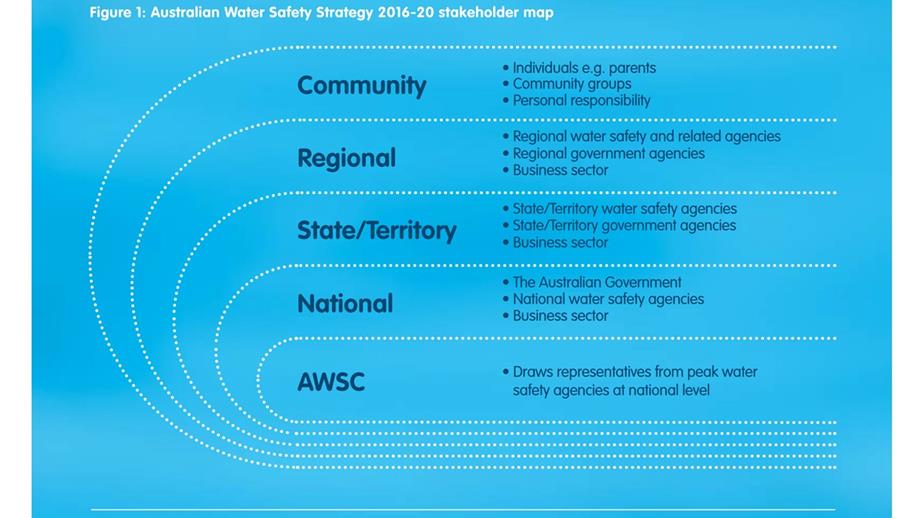Establishing the Australian Water Safety Council
Case Study
Country: Australia
Authors: Amy Peden
Organisation: Royal Life Saving Society, Australia
Background
In Australia, an average of 282 people die as a result of unintentional drowning every year. Drowning occurs across the lifespan and in a variety of aquatic locations while undertaking a range of activities, most commonly recreational.
In order to address the prevention of unintentional drowning in Australia, the Australian Water Safety Council (AWSC) was officially formed in February 1998 as a result of strong industry consultation and Federal Government support. The Council acts as a consultative forum comprising the major water safety organisations and related government agencies. The AWSC focuses on the presentation of key water safety issues to governments, industry and the community. The Council provides a collective voice for Australia’s leading water safety organisation.
The AWSC is committed to reducing drowning and improving water safety in Australia as demonstrated through the production and implementation of the National Water Safety Plans/Strategies. These documents have generated bipartisan support for water safety in Australia and have seen the improvement of water safety throughout the country.
Aims
The AWSC acts as a consultative forum comprising the major water safety and related government agencies and focuses on the presentation of key water safety issues to governments, industry and the community. The Australian Water Safety Strategies draw on evidence, including fatal and non-fatal drowning data, to highlight drowning issues and guide prevention efforts.
Methods
The AWSC member bodies demonstrate their commitment to water safety by contributing resources towards the development and implementation of the Australian Water Safety Strategies, and the conduct of workshops and conferences. The AWSC does not receive funding directly.
The AWSC meets several times a year and releases a National Water Safety Strategy every 3-4 years. Strategies are grounded in the analysis of drowning data and highlight approximately 10 goal areas where action is required to reduce drowning in Australia. In previous years, the AWSC has also brought together drowning prevention researchers and practitioners through the Australian Water Safety Conference.

Impact
The AWSC has focused efforts on evidence-based drowning prevention issues and strategies since its iteration. The national document, the Australian Water Safety Strategy, guides the distribution of Federal Government funding for drowning prevention research, policy and practice.
The national body has spawned State and Territory Councils in many jurisdictions. Several States and Territory Councils have also drafted their own water safety strategies and state level of funding is often guided by these strategies.
The AWSC’s aspirational goal of a 50% reduction in drowning by the year 2020 has been successful in drawing the drowning prevention sector together towards a common goal and provides a goal that success can be measured against.
Challenges
The AWSC receives no funding and as such, relies on the contributions of its member organisations (primarily Royal Life Saving as convenors and secretariat, and Surf Life Saving and AUSTSWIM as partners) to hold conferences, draft and release strategies and provide a united voice on drowning prevention issues to government.
A separate challenge has been achieving the aspirational goal of a 50% reduction in drowning by the year 2020. As data quality and analysis improved over time, a more nuanced analysis of progress against this goal has been undertaken, with positive achievements seen in young children, while other issues, such as males and older people, remain a challenge for prevention.
Lessons learned
The development and ongoing maintenance of the AWSC and the Australian Water Safety Strategy are powerful tools for bringing drowning prevention issues to the forefront, particularly with Government. The establishment of State and Territory level Councils and Water Safety Plans has shown the power behind such a concept.
The AWSC and the Australian Water Safety Strategy have drawn the Australian drowning prevention sector towards a single goal and increased the rigour around the evidence-based discussion of drowning and the implementation of evidence-based strategies for prevention.
In an environment where specific funding for the establishment of a council and the development of Strategies may not be achievable, a champion organisation, with the funds and resources to get the ball rolling and maintain commitment, will be required.
Costs and replicability
This model relies on the support of larger scale non-government organisations (NGOs). The AWSC is supported by its lead member organisations, secretariat Royal Life Saving Society – Australia and members Surf Life Saving Australia and AUSTSWIM. The AWSC structure and Strategies could be replicated in other contexts, particularly in countries where similar NGOs exist and where government funding for drowning prevention may be achievable.

References
Royal Life Saving Society – Australia (2016) National Drowning Report 2016, Royal Life Saving Society – Australia, Sydney.
Australian Water Safety Council (2017) Australian Water Safety Council Website, Australian Water Safety Council, Sydney.
Australian Water Safety Council (2016) Australian Water Safety Strategy 2016-2020, Australian Water Safety Council, Sydney. (PDF 3.16MB)
Further information/resources
Australian Water Safety Council
Australian Water Safety Strategies
Step 2
Establish leadership